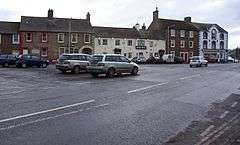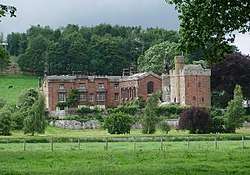Dalston, Cumbria
Dalston is a large village and civil parish within the Carlisle district of Cumbria, historically, part of Cumberland. It is situated on the B5299 road about four miles (6 km) south-south-west of Carlisle city centre, and approximately five miles (8 km) from Junction 42 of the M6 motorway.
| Dalston | |
|---|---|
 The Square at Dalston | |
 Dalston Location within Cumbria | |
| Population | 2,590 (2011)[1] |
| OS grid reference | NY395555 |
| • London | 261 mi (420 km) SSE |
| Civil parish |
|
| District | |
| Shire county | |
| Region | |
| Country | England |
| Sovereign state | United Kingdom |
| Post town | CARLISLE |
| Postcode district | CA5 |
| Dialling code | 01228 |
| Police | Cumbria |
| Fire | Cumbria |
| Ambulance | North West |
| UK Parliament | |
Description
The village is on the River Caldew, just to the north of where the Roe Beck joins the river. It is served by the Dalston railway station on the Cumbrian Coast Line between Carlisle, Workington and Barrow in Furness, taking over two hours for the full journey. There are two popular schools in Dalston, St. Michaels Primary School and Caldew Secondary School which has over a thousand pupils. There is also a Nestlé factory producing powdered milk, a BP fuel depot and a factory producing specialist materials.
Dalston has a population of around 2,500 and serves as a key service centre for a much wider rural area. At the centre is the Square, which is not square, dominated by St Michael's and All Angels Church. Most of the shops are located in and around the Square. To the northwest of the centre of the village is the Barras Lane trading estate, home to many businesses.
There is a county electoral division of Dalston, stretching north towards Carlisle, with a total population at the 2011 United Kingdom census of 6,051.[2]
History

Rose Castle, home of the Bishop of Carlisle for many centuries until 2009, is within the parish of Dalston, 1.5 miles (2.4 km) from the heart of the village. The Architects Anthony Salvin and Thomas Rickman were responsible for the alterations which took place in the 19th Century.
Dalston Hall is a grade II* listed fortified house which is now a country house hotel.[3]
Notable people
- Sir James Graham, 2nd Baronet (1792–1861) was educated at Dalston.[4]
- Georgiana Harcourt (1807–1886), translator, was born at Dalston while her father Edward Venables-Vernon-Harcourt was Bishop of Carlisle.[5]
- William Paley (1743–1805), was Vicar of Dalston in the 1780s.[6]
- Edward Rainbowe (1608–1684) lived here while Bishop of Carlisle.
- George Robinson (1737–1801), London publisher, was born here.[7]
- Musgrave Watson (1804–1847), sculptor, was born here.
References
- "Parish population 2011". Retrieved 24 June 2015.
- "Ward population 2011". Retrieved 24 June 2011.
- "Dalston Hall Ny 376515, Dalston". British Listed Buildings. Retrieved 10 September 2013.
- Jonathan Parry, "Graham, Sir James Robert George, second baronet (1792–1861)", in Oxford Dictionary of National Biography (OUP, 2004) online at doi:10.1093/ref:odnb/11204 (subscription required)
- Baptism on 27 July 1807 at the Parish Church, Dalston: “Georgiana Charlotte Frances Harcourt daughter of Edward and Ann Harcourt”
- James E. Crimmins, "William Paley (1743–1805)" in Oxford Dictionary of National Biography (OUP, 2004)
- Henry Richard Tedder, ”Robinson, George“, in Dictionary of National Biography, 1885-1900, Volume 49